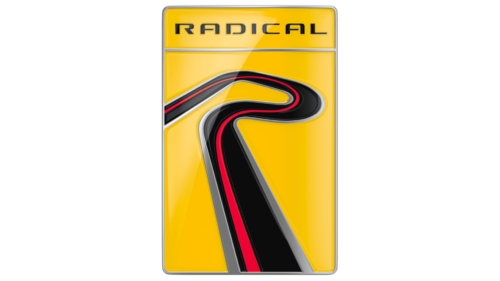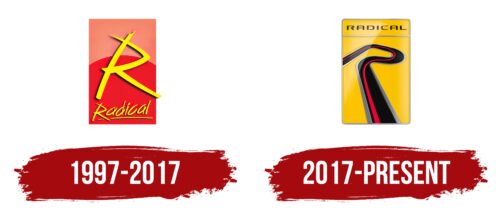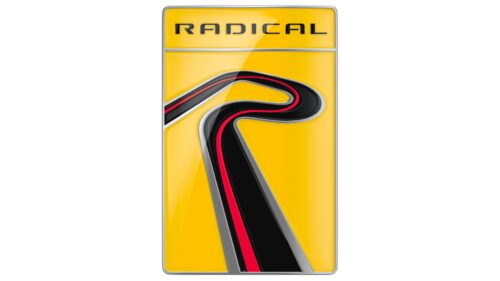The Radical logo is bright and expressive, perfectly capturing energy with emotions and positivity. It concentrates the intensity that typically accompanies racing track competitions. The emblem is full of passion, dynamism, and the tense anticipation of victory.
Radical: Brand overview
Radical Motorsport, a British company known for crafting high-performance sports and racing cars, has a history of bold innovation and impressive racing achievements.
In 1997, Mick Hyde and Phil Abbott founded the company in Peterborough, UK, driven by a vision to create affordable, high-performance racing cars for enthusiasts. By 1998, the company unveiled its first model, the Radical 1100 Clubsport, featuring an 1100cc Kawasaki motorcycle engine. This prototype set the stage for the brand’s success in motorsport.
By 2000, the company expanded its lineup with the SR3 model, quickly becoming one of its most successful vehicles. The SR3 offered remarkable performance at a reasonable price, solidifying the brand’s reputation in motorsport circles.
2002, the company began exporting its cars internationally, earning global recognition. In 2005, the launch of the Radical SR8 marked a significant milestone as it became the first Radical car homologated for road use, blending track performance with street legality.
The company gained worldwide attention in 2007 when the SR8 LM set a new lap record for production cars at the Nürburgring Nordschleife, completing the lap in just 6 minutes and 55 seconds. This achievement showcased the brand’s engineering excellence.
In 2011, the company introduced the SR3 SL, their first car powered by a turbocharged Ford EcoBoost engine. This model marked another leap forward in performance and reliability. Two years later, in 2013, the company unveiled the RXC, its first fully enclosed car designed for both track and road use, expanding its appeal to those seeking high-performance vehicles with practical usability.
To meet growing demand, the company opened a new production facility in Peterborough in 2015, significantly boosting manufacturing capacity. This expansion coincided with the company’s 20th anniversary in 2017, which was celebrated with a special edition, SR3, commemorating two decades of innovation and racing success.
In 2019, following the founders’ departure, the company underwent restructuring under new leadership, setting the stage for the next growth phase. In 2020, the company continued to innovate, developing new models and maintaining strong customer support. This resilience was demonstrated by introducing the updated SR3 XX and the new SR10 in 2021, featuring advanced engineering and performance enhancements.
Throughout its history, the company has carved out a unique niche in the automotive world, offering cars that deliver the thrill of racing prototypes with the practicality and affordability enthusiasts desire. The company also organizes its racing series in various countries, promoting the brand and fostering a dedicated community of owners and drivers.
Meaning and History
What is Radical?
It is a British manufacturer known for producing racing cars. The company specializes in lightweight sports cars for track and road use. The vehicles’ exceptional speed, agility, and advanced engineering are recognized. The brand has significantly impacted motorsports, offering a range of models catering to amateur and professional racers alike.
1997 – 2017
The British sports car manufacturer chose an emblem rich in symbolism, representing many aspects of the automotive world in every square inch. Its key characteristics are lightness, positivity, and simplicity, conveyed through straightforward details that even non-car enthusiasts can appreciate. Simultaneously, the logo exudes modernism and extravagance.
The unique aura of the Radical emblem is crafted through sharp strokes, precise angles, jagged lines, and steep curves reminiscent of the racing track turn that high-speed sports cars navigate in an instant. The single letter highlights the super capabilities of these cars – their grandeur and unmatched performance.
- The center features a large “R” composed of three parts. The first element is a vertical side stripe positioned at an angle, with a jagged top and uneven width. The second detail is a triangle with one open side, resembling the mathematical “greater than” sign or a boomerang. The third part appears as a horizontal stroke, slightly raised on the left, representing the leg of the single “R.”
- Below is the name of the car manufacturing company. It follows the same style as the top glyph – deliberately rough, with angular and abrupt lines, designed to evoke a positive response among young people. The inscription uses a unique font with no analogs. Each letter features a common element resembling a sharp turn on a racing track, distinctly seen in the lowercase “a,” “d,” and “c.”
The background deserves special mention. It is a vertically positioned rectangle, interestingly colored in two shades of red: coral at the top and crimson at the bottom. The lower element has a semicircular shape reminiscent of the sun. This holds deep symbolism, reflecting the company’s initial drive for gradual production expansion and visually embodying the rising dream.
Subtle shadows in the lettering convey the aesthetic and beauty of the Radical emblem. The name and the first letter have edge shading, giving them a three-dimensional, floating appearance above the background. This 3D effect harmoniously complements the logo, transforming the flat symbol into an exclusive three-dimensional element that intricately reflects the brand’s concept.
2017 – today
To keep up with the times and be progressive and successful, the British supercar manufacturer has redesigned its identity, opting for a more modern emblem. Its main feature is a youthful style—the redesign aimed to broaden the consumer audience and attract the attention of the younger generation of motorists. The company’s concept regarding the logo remains unchanged, maintaining a preference for bright, modern, and relevant designs with an emphasis on a vertical form.
The modernization results in a rectangular sign divided into two zones by a thin silver stripe that smoothly turns into a frame. The upper part is narrow and small, fully reformatting the brand name. It is a strict inscription with geometric glyphs, with parts of the strokes missing, giving the letters an unusual look. Their uniqueness aims to turn the name into a racetrack, showcasing the range of cars and setting the tone for an impressive race, confirming the reliability of the technology.
The font is uppercase, smooth, even, and sans-serif. The absence of serifs indicates that the car manufacturer is open to dialogue with customers, ready to listen to their opinions and offer the best option. It also signifies the high power of the brand’s sports cars, for which there are no obstacles.
The lower half of the Radical logo now contains a completely different element, entirely unlike the previous one, but also consisting of winding lines. This reflects the significant technical capabilities of the engineering company, directly indicating that its cars are fully adapted to steep racing tracks with sharp turns. This helped the brand demonstrate the high professionalism of its employees, promote its products, and confirm its authenticity.
The absence of corners, soft curves, and smooth lines symbolize the company’s customer focus and convey its name: an improvised racetrack repeats the contour of the capital “R,” whose edges merge with the frame. The stylish letter is painted black and complemented by a light raspberry stripe resembling a sports car’s trajectory.
Another important feature of the sign is the shine, which is laminated or coated with a colorless protective layer to protect it from damage. Additionally, the gloss gives the emblem volume and makes it tangible, instilling the idea of cars’ wide availability and showing the high level of their protection, reliability, and maneuverability.






